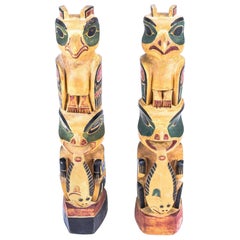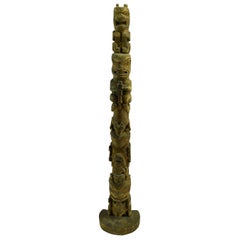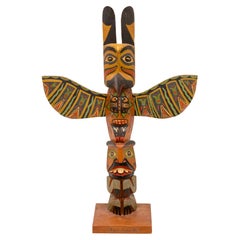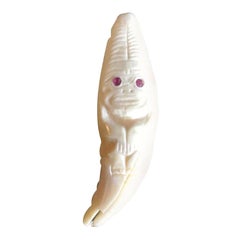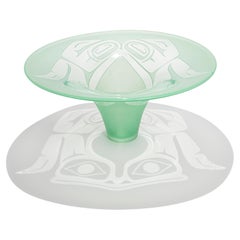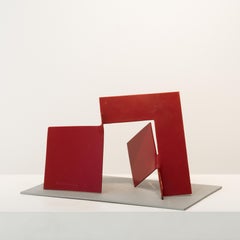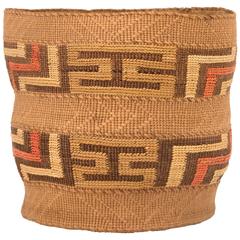Tlingit Art
Pair of 1930s Tlingit Totems
Located in Coeur d'Alene, ID
Tlingit culture is divided into two moieties, or groups: Eagles and Ravens. These groups, also
Category
Vintage 1930s American Native American Native American Objects
Materials
Cedar
19th Century Multi-Figure Tlingit Totem
Located in Coeur d'Alene, ID
Complex Multifigure Tlingit Totem Pole from Sitka, Alaska. This larger red cedar model totem pole
Category
Antique Late 19th Century American Native American Native American Objects
Materials
Cedar
Hand-Carved Tlingit Totem Pole
By Native American Art
Located in Coeur d'Alene, ID
Tlingit hand-carved totem with wings painted in a Norwegian style. Marked on back Maria Pease IV
Category
Early 20th Century American Native American Native American Objects
Materials
Wood, Paint
Pacific Northwest Coast Tlingit Shaman's Grizzly Tooth Pendant, circa Late 1800s
Located in Studio City, CA
A fantastic Northwest Coast Tlingit tribe shaman's pendant carved from Grizzly Tooth with jeweled
Category
Antique 19th Century Canadian Sculptures and Carvings
Materials
Teeth
$1,245
H 3 in W 1 in D 0.5 in
Early Glass Sculpture Vessel from Tlingit Hat Series by Preston Singletary
Located in Atlanta, GA
entire iconography of glass art drawn from Tlingit motifs, but his forms are somewhat abstracted, giving
Category
1990s American Modern Abstract Sculptures
Materials
Art Glass, Blown Glass
$18,500
H 7.5 in Dm 16.75 in
Recent Sales
Tlingit, steel sculpture painted red (maquette)
By Robert Murray
Located in Halifax, Nova Scotia
collections including National Gallery of Canada, AGO, Montreal Museum of Fine Arts, University of Toronto Art
Category
2010s Abstract Geometric Abstract Sculptures
Materials
Steel
Antique Northwest Coast Berry Basket, Tlingit
Located in Denver, CO
A flat bottomed cylindrical berry basket with a very fine weave with Classic Tlingit geometric
Category
Early 20th Century American Native American Native American Objects
Materials
Natural Fiber
Vintage American Indian Rattle-Top Basket, Northwest Coast, circa 1920
Located in Denver, CO
A combination of Spruce Root fibers and native grasses intricately twined by a Tlingit woman around
Category
Early 20th Century American Native American Native American Objects
Native American Tlingit Beaded Pouch or Wall Pocket
Located in London, GB
Native American Rare Tlingit Beaded pouch or wall pocket
Northwest Coast America
Cloth and
Category
Early 20th Century American Native American Objects
Materials
Wool, Cotton
Early 20th Century Native American Northwest Coast Bear Comb, Probably Tlingit
Located in Point Richmond, CA
Early 20th Century Native American Northwest Coast Bear Comb, Probably Tlingit
The comb depicts a
Category
Early 20th Century Canadian Other Native American Objects
Materials
Wood, Paint
H 6.5 in W 3 in D 2 in
Antique Native American Basketry Gathering Bowl, Tlingit, 20th Century
Located in Denver, CO
A tightly woven Pacific Northwest coast gathering basket.
The Tlingit peoples are indigenous
Category
20th Century American Native American Native American Objects
Materials
Natural Fiber
Native American Lidded Basket, Tlingit 'Pacific Northwest Coast, ' circa 1900
Located in Denver, CO
crosses of red, gray, green and yellow yarns.
The Tlingit peoples are indigenous to the Pacific
Category
Early 20th Century American Native American Native American Objects
Antique Northwest Coast/Native American TOTEM Pole, Tlingit, 19th Century
Located in Denver, CO
Tlinget carver. The Tlingit peoples are indigenous to the Pacific Northwest Coast; inhabiting southeastern
Category
Antique 19th Century American Native American Sculptures and Carvings
Materials
Wood
Antique Northwest Coast Carved Frontlet, Tlingit/Tsimshian, late 19th century
By Native American Art
Located in Denver, CO
Antique Native American Indian Tlingit carved plaque with a stylized bird form. Custom display
Category
Antique 19th Century American Native American Sculptures and Carvings
Materials
Wood
Pacific Northwest Coast Native American Haida Tlingit Framed Blanket Rug
By Native American Art
Located in Studio City, CA
rug (likely Haida or Tlingit) featuring two colorful tribal birds.
Nicely framed.
We are listing
Category
20th Century Canadian Native American Native American Objects
Materials
Wool
Tlingit button blanket circa 1930's
Located in Pawtucket, RI
Fantastic North West coast Button Blanket. Handmade with a Hudson Bay "Corranation" Trade blanket with hand carved buttons of Abelone and Mother of Pearl shells and stroud cloth. St...
Category
Vintage 1930s Native American Objects
Materials
Wool, Mother-of-Pearl
Tlingit American Indians Drawing Print of Raven, Signed C. Saslow
Located in Haddonfield, NJ
American Alaskan Tlingit Artwork Drawing of a Raven dated 1976. This colorful art featuring colors
Category
Mid-20th Century American Mid-Century Modern Decorative Art
Materials
Wood, Paper
Pacific Northwest Tlingit Whale House Rain Wall from Donald Judd Estate, c. 1968
Located in Fort Lauderdale, FL
Pacific Northwest Tlingit whale house rain wall from Donald Judd Estate c. 1968
A monumental
Category
Vintage 1960s Canadian Native American Native American Objects
Materials
Cedar, Paint
H 108 in W 192 in D 2 in
Tlingit Bear Mask, 1965-1975
Located in Paris, FR
Tlingit Bear Mask, 1965-1975
Wood, rawhide, painting, leather straps, rope
Category
1960s Figurative Sculptures
Materials
Wood
Death Mask of Tlingit Woman, 1965-75
Located in Paris, FR
Death Mask of Tlingit woman, 1965-75
Wood, abalone (labret, pedants earrings and necklace), paint
Category
1960s Figurative Sculptures
Materials
Wood
Fine & Rare Tlingit Spruce Root Basket
Located in West Palm Beach, FL
Fine & rare large Tlingit Indian spruce root basket. Spruce roots must be gathered, sorted and
Category
Early 20th Century Native American Objects
North West Coast Tlingit Wood Totem with Potlatch Rings
Located in New York, NY
Carved cedar wood totem with a squatting beaver shaman holding a rattle in each hand, the ends flanking his mouth which bares a wide, toothy grimmace, short snout above and recessed ...
Category
Antique 19th Century Canadian Tribal Art
Materials
Wood, Pigment
Anonymous | Tlingit Totem Pole
Located in Wyomissing, PA
N.W. Coast Transformational Ceremonial Totem, Potlatch, Traditional Colors
Category
Antique 19th Century American Folk Art Sculptures
Native American Old North West Coast Painted Cedar Dance Paddle Haida Tlingit
Located in London, GB
Native American old north west coast painted cedar dance paddle Haida Tlingit
A fine painted cedar
Category
Early 20th Century Greenlandic Native American Objects
Materials
Composition
H 33.08 in W 3.94 in D 0.79 in
People Also Browsed
Natural Parota Brutalist Sculptural Collage Artwork, Mural from Upcycled Wood
By Peter Glassford
Located in San Antonio, TX
These NATURAL PAROTA collage tiles are composed randomly from recycled wood remnants and when installed bathe any space with a warm feeling and texture which is meditative, sanded to...
Category
2010s Mexican Brutalist Contemporary Art
Materials
Wood
$70 / item
H 23.5 in W 23.5 in D 1 in
"Pietra" Curved Armchair with Leather Arms Upholstered in Bouclé Fabric
By Studio Marta Manente
Located in Centro, RS
Pietra from Italian: Stone
The designer Marta Manente is of Italian descent, her great-grandparents migrated from Italy over 100 years ago and lived in the region of Bento Gonçalves ...
Category
21st Century and Contemporary Brazilian Modern Armchairs
Materials
Bouclé
$3,969 / item
H 28.35 in W 40.16 in D 34.65 in
Northwest Coast Totem by Marlin Alphonse
By Native American Art
Located in Coeur d'Alene, ID
Colorful Alaskan three figure winged totem. Carved and painted by Marlin Alphonse. Noted on back "purchased by Brad and Hazel Ritter on board Royal Princes, Sitka, Alaska 1986. His n...
Category
Vintage 1980s American Native American Native American Objects
Materials
Cedar
Renaissance Style Oak Tester 4 Poster Bed Armorial Tapestry Bedspread King Size
Located in BUNGAY, SUFFOLK
A vintage king size oak tester or four poster bed in the Renaissance style. Hand carved with Adam & Eve carvings in the headboard, figurative sculptures in the bedposts, three carve...
Category
Mid-20th Century English Renaissance Beds and Bed Frames
Materials
Oak
$62,678
H 88.98 in W 70.87 in D 94.89 in
Portrait of Lady Caroline Price
By George Romney
Located in Miami, FL
DESCRIPTION: Perhaps the best Romney in private hands. If Vogue Magazine existed in the late 18th century, this image of Lady Caroline Price would be on one of its covers. The e...
Category
1970s Old Masters Portrait Paintings
Materials
Oil, Canvas
John Williams Signed Indigenous American West Coast Haida Styled Totem Pole
Located in Hamilton, Ontario
This Indigenous American totem pole was done by the renowned master carver John T. Williams of the United States in approximately 1960 in his signature West Coast Haida style. The sc...
Category
Mid-20th Century American Native American Native American Objects
Materials
Cedar
$2,500
H 19 in W 17.5 in D 4.75 in
Native Nootka Totem by Rick Williams, 2 Foot
By Native American Art
Located in Coeur d'Alene, ID
Rick Williams (Nootka / Nuu-chah-nulth, b. 1955). 2 Foot Red Cedar Seattle Pole" painted wood sculpture hand carved by Rick Williams and signed with title on verso of pole. A wonderf...
Category
20th Century Canadian Native American Native American Objects
Materials
Cedar
Tiffany & Co. San Lorenzo Silver Flatware Service, 248 Pieces
By Tiffany & Co.
Located in New Orleans, LA
This extensive 248-piece sterling silver flatware service was crafted by the legendary Tiffany & Co. in the classic San Lorenzo pattern. Inspired by and named after the famous Floren...
Category
Early 20th Century American Renaissance Revival Tableware
Materials
Sterling Silver
Set of Monumental Bronze Egyptian Figures
By Charles Cameron
Located in Queens, NY
Set of 4 Russian (19th Century) monumental bronze Egyptian figures emblematic of the Months on painted bases after those by C. Cameron & M. Alexandrov for the Egyptian Vestibule at P...
Category
Antique 19th Century Russian Neoclassical Sculptures
Materials
Bronze
Flemish 17th, Orpheus and Animals, Large Decorative Wall Old Master Painting
Located in Greven, DE
Flemish school, 17th century
Orpheus and the animals
Oil on canvas, 146,5 x 217 cm
Provenance: South German private collection.
On an impressive, room-filling format, this painting ...
Category
17th Century Baroque Landscape Paintings
Materials
Canvas, Oil
$204,094
H 57.68 in W 85.44 in
Rare Moses Michelangelo Guggenheim & Pauly Cie Et Venice Antique Carved Armoire
By Guggenheim Museum, Pauly et Cie
Located in West Sussex, Pulborough
We are delighted to offer for sale this very rare one of a kind Pauly CIE Et stamped hand carved walnut armoire made by the genius that was Moses Michelangelo Guggenheim 1837-1910
W...
Category
Antique 19th Century Italian Victorian Wardrobes and Armoires
Materials
Walnut
$208,929 Sale Price
40% Off
H 100.6 in W 66.93 in D 24.81 in
Men Drinking Coffee
By Norman Rockwell
Located in Fort Washington, PA
Signed by Artist Lower Right
Maxwell House Coffee
Category
1920s Figurative Paintings
Materials
Oil
The Jester, Post Cover
By Norman Rockwell
Located in Fort Washington, PA
Signed by Artist Lower Right
The Saturday Evening Post, February 11, 1939, cover illustration
Literature
The Saturday Evening Post, February 11, 1939, cover illustration
Thomas S....
Category
1930s Figurative Paintings
Materials
Oil
Ditidaht/Nuu-chah-nulth Totem by Raymond Williams
By Native American Art
Located in Coeur d'Alene, ID
(1933-1988) This finely crafted wood totem pole is by Ditidaht/Nuu-Chah-Nulth master carver Raymond Williams, the father of the current generation of William's carvers. The carved to...
Category
Vintage 1950s Canadian Native American Native American Objects
Materials
Cedar
A Magnificent Pair of French Royal Paintings "Aurora and Diana" "Night and Day"
Located in Queens, NY
Jacques-Francois Delyen (1684-1761), Court Painter of King Louis XV.
A Magnificent Pair of Palatial "French Royal" Allegorical Paintings "Aurora and Diana" "Night and Day"
A truly ...
Category
18th Century Portrait Paintings
Materials
Oil
Art Nouveau paneling in Walnut with a wood Fireplace with Ceramic
Located in SAINT-OUEN-SUR-SEINE, FR
This exceptional Art Nouveau style pine and burr paneled room is beautifully carved and decorated with blue-green ceramics. Panels with elegant curved and sober lines are covering th...
Category
20th Century French Art Nouveau Panelling
Materials
Ceramic, Wood, Walnut
$154,683
H 127.56 in W 208.67 in D 144.49 in
Get Updated with New Arrivals
Save "Tlingit Art", and we’ll notify you when there are new listings in this category.
Tlingit Art For Sale on 1stDibs
With a vast inventory of beautiful furniture at 1stDibs, we’ve got just the piece of tlingit art you’re looking for. An item from our selection of tlingit art — often made from wood, cedar and fabric — can elevate any home. There are many kinds of the choice in our collection of tlingit art you’re looking for, from those produced as long ago as the 19th Century to those made as recently as the 20th Century. When you’re browsing for the right object in our assortment of tlingit art, those designed in Folk Art styles are of considerable interest. You’ll likely find more than one option in this array of tlingit art that is appealing in its simplicity, but Native American Art produced versions that are worth a look.
How Much is a Tlingit Art?
Prices for a piece of tlingit art can differ depending upon size, time period and other attributes — at 1stDibs, they begin at $275 and can go as high as $15,000, while the average can fetch as much as $4,818.
More Ways To Browse
Native American Pouch
Aboriginal Carvings
Native American Haida
Totem Pole Salish
Grave Marker
Aboriginal Wood Carving
Williams Totem Pole
Williams Totem
Joe Spoon
Native American Rattle
Native American Spoon
Haida Box
Railroad Finial
Blown Glass Whale
Haida Carved Wood
Native Beaded Pouch
Aboriginal Totem Pole
Alaska Basket
